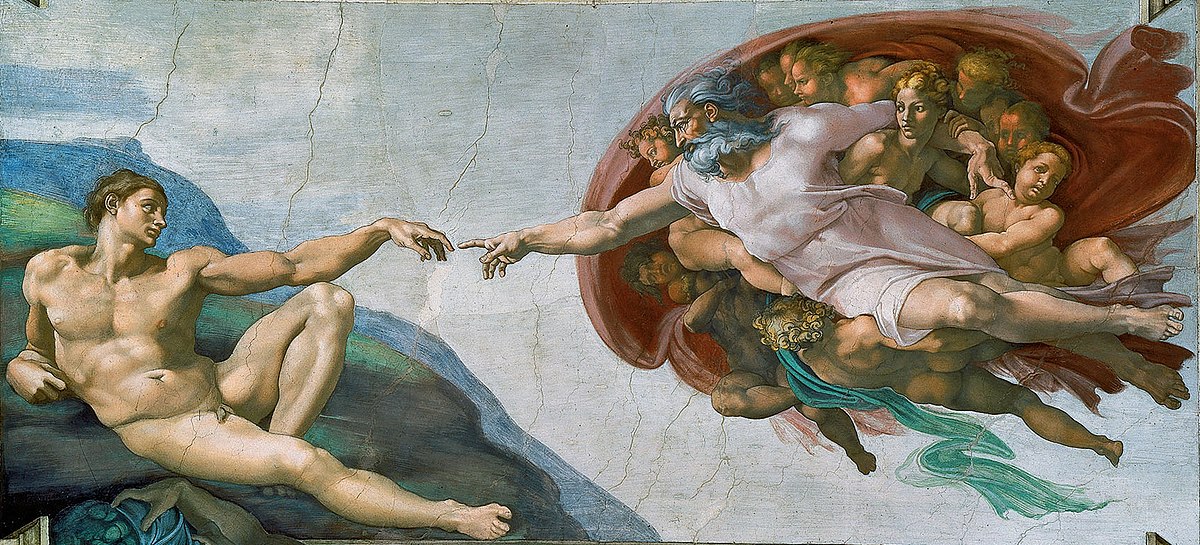Michelangelo - VM - JW and J Scheurwater
Michelangelo: The Creation of Adam

The Finger of God
by Jan-Willem and Jannet Scheurwater
The well-known image of the hands of God and Adam is part of the frescos Michelangelo painted on the ceiling of the Sistine Chapel (1508 -1512). God’s finger reaches towards Adam’s finger, almost but not quite touching it. Even though this painted ceiling is Michelangelo’s most famous work, the artist saw himself first of all as a sculptor. He said that his fascination for sculpture was poured into him by the milk of the woman who breastfed him, the wife of a stonecutter. This preference for sculptured forms is visible in his paintings: the people he depicted are like Greek statues one can walk around. Statues from antiquity were rediscovered in the time of the Renaissance and strongly influenced Michelangelo.
Why does Michelangelo portray the creation of Adam by means of the finger of God touching him? Is there a biblical background for this?
In the Old Testament we come across the expression ‘the finger of God’ twice. Moses says that God wrote the Law on the two stone tables with his finger (Exodus 31:18). David sings: ‘When I look at your heavens, the work of your fingers, the moon and the stars that you have established; what are human beings that you are mindful of them…?’ (Psalm 8:3-4a).
Luke as well as Matthew describe an intense episode of Jesus exorcising a demon (Luke 11:14-23 and Matthew 12:22-30). Luke remarks that Jesus sends the demon away by the finger of God (verse 20). Matthew remarks that he does this by the Holy Spirit (verse 28). Both gospel writers attempt to find words for the spiritual power that emanates from Jesus here. The one calls it ‘the finger of God’, the other ‘the Holy Spirit’.
We can conclude that the finger of God can be an image for the Holy Spirit. It is fascinating that this is visible in Michelangelo’s fresco of the creation of Adam. God, the Creator, has just formed Adam out of a lump of clay. Genesis tells us that God animates this by breathing a living soul into the first human being. He blows his breath through the nostrils into the body and it comes to life. People who have nearly died and been reanimated – and those who have reanimated them – have some inkling of what that means.
In Michelangelo’s work God does not breathe into Adam but reaches out to touch him with his finger. It is this that calls Adam’s body to life. Just as in Luke, Michelangelo portrays God’s Spirit here by the finger of God. It is intriguing that the finger of God does not quite touch Adam. This ‘not quite’ expresses the mystery. What actually happened is far beyond words or an image to express and can only be implied suggestively.
The liturgy of the Church is saturated with biblical concepts and there is a well-known hymn from the early Middle Ages that could very well have inspired Michelangelo in this painting of Adam. The hymn Veni Creator Spiritus contains the idea of the Holy Spirit as God’s finger. The hymn occupies an important place in the liturgy. It is not only sung on Pentecost, but also when priests are ordained and at other important moments in the life of the church. In this hymn the Holy Spirit is worshiped and addressed with multiple names. The third stanza reads:
Tu septiformis munere (You, bearing presents sevenfold)
digitus paternae dexterae (Finger of God’s right hand)
tu rite promissum Patris (You, who are the promised gift of the Father)
sermone ditans guttura (bestow on us the ability to speak)
Listen and look at the hymn being sung here.
This ancient hymn states that the Finger of God’s right hand, the Holy Spirit, hands Adam the gift of speech – which we also see in Michelangelo’s fresco. Maybe it is speech which makes human beings most alike their Creator. Michelangelo captured it with consummate skill.
*******
Michelangelo: The Creation of Adam, 1508-1512, fresco, 2,3 x 4,8 m. Sistine Chapel, Rome.
Michelangelo Buonarroti (1475-1564) was an Italian Renaissance sculptor, painter, architect and poet. He is considered one of the greatest artists ever. He worked in Florence and Rome. As a student in the household of Lorenzo de' Medici Michelangelo met some of the greatest thinkers and artists of his days. In 1496 he moved to Rome, where one of his first major assignments was the now well-known Pietà in St Peter's Basilica. Back in Florence Michelangelo created several other masterpieces, including the David (1501-1504). Pope Julius II commissioned him to decorate the ceiling in the Sistine Chapel (1508-12). The frescoes depict prophets, sibyls and scenes from Genesis, translating from sculpture into painting Michelangelo's preference for strong, muscular figures. He returned to the Sistine Chapel in 1536 to begin the huge Last Judgment on the altar wall, finishing the work in 1541. In 1547 he was unwillingly put in charge of the rebuilding of St Peter's, and had a decisive influence over its final design. Michelangelo died in Rome in 1564. He is buried in the church of Santa Croce in Florence.
Jan-Willem and Jannet Scheurwater write blogs about classical music and visual art, see www.muzeaoide.blogspot.nl.
ArtWay Visual Meditation Pentecost 2018


